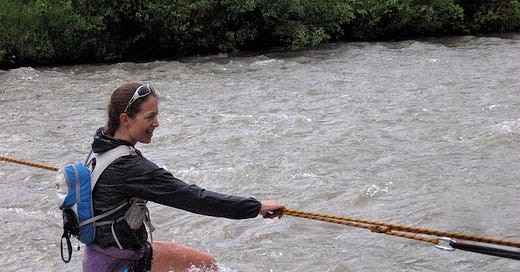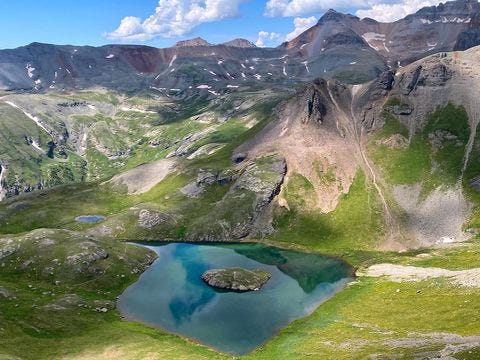What’s your most memorable ultrarunning experience?
That’s the prompt for the annual UltraRunning magazine contest that awards a Western States 100 entry to the winner.
My mind shuffles through flashbacks while my eyes survey medals and buckles near my desk. Every ultra is memorable, even those remembered as a tedious purgatory. How do you pick the single most memorable? How would you describe it in 250 words, the contest’s word limit?
Here goes.
Baptism by Hardrock
The sky shot marble-sized pellets of hail that stung my bare thighs. The mountainside near Silverton seemed to tremble with each clap of thunder. Storm-swollen runoff carried debris down the trail that washed against my ankles, and cold robbed the feeling from my fingers.
Mother Nature’s wrath had never engulfed me to such a degree. I ran hunched over, bent at the waist, to shrink from forked lightening striking too close for comfort. In one unforgettable second, I saw a melon-sized rock fly directly in front of my eyes, barely missing my head.
Waiting out the storm wasn’t an option. We were above tree line, and hypothermia would set in if we stopped. Most worrisome of all, we had only about 90 minutes of daylight left—and no headlamps—to go six treacherous miles.
It was 2011, I was 42, and this was my initiation to the Hardrock 100 route in the San Juan Mountains.
I was a pacer for the final 30 miles, and like an apprentice, I soaked up every piece of knowledge I could get from the experienced ultrarunner, Garett Graubins, who had invited me to accompany him. Over three massive high-altitude passes, the route brought me to my knees as I crawled up a scree headwall and scrambled over a beaver dam. I would briefly pause to take in the panorama then refocus my gaze straight ahead, committed to forward movement.
Near the finish, we had to cross a raging creek, so I plunged into the thigh-high frigid flow. I did not hesitate, I did not flinch. I had sensed the mountains’ power and felt as tiny as an ant on a wall, but as I met each challenge in each mile, confidence grew and fear became thrill.
Those 30 miles in the San Juan Mountains turned me into a legit mountain runner. When we finished, I knew where I belonged and what I wanted to be.
That’s all—that’s a tight word limit! (I went over it a bit.) If you would like to enter the contest, here’s how it works: Through November 24, 2022, contestants will submit their answers in 250 words or fewer. The criteria will be based on the most compelling entries, with an emphasis on overcoming challenges, fostering the culture of the sport, and personal transformations. Details here.
I won’t enter my very short story above for consideration, because running Western States in 2023 is not a goal. I have my sights on the Thames Path 100 in May instead, then a mountain 100 over summer (of course, I hope that’s Hardrock.) I would, however, like to experience Western States once again in my lifetime, so I threw my name (like throwing the imaginary snowball in hell) into the lottery to begin the years-long process of building a ticket count.
The New Hardrock Lottery
It’s lottery season for both States and Hardrock, and we’ll know the outcomes December 3. With 64 tickets in Hardrock’s lottery, my flame of hope flickers just a little stronger this year, even though more than 2000 people—each with multiple tickets built up over the years—are vying for the precious 144 spots. (The total number of runners will be 146, but last year’s male and female winners automatically gain two of the spots.) Two new lottery rules have improved the chances of “Nevers” (people like me who’ve never run it) gaining entry and of women gaining more spots.
Half the entries, 73, will go to Nevers, and the other half to “Finishers” who’ve finished Hardrock at least once. In past years, the “Finishers” were divided into two separate pools (“Veterans” and “Elses”) that gave more than half the spots to prior finishers, with odds weighted in favor of those who’d run it five or more times. Now, the lottery’s playing field feels more level for us Nevers.
The percentage of women chosen to start will not be less than the percentage of applicants that are women. As of now, 20.5 percent of the applicants are female. So at least 20.5 percent of the entries, or 30 total, will go to women (and additional women may be drawn for the remaining 116 spots if lucky).
If these lottery rules make your eyes glaze over, I get it—it’s complicated. But it’s a topic that hundreds of people like me are geeking out about. This page details the complex system.

When I first paced Hardrock back in 2011, only 16 of the competitors that year were female. In 2022, women made up 27 of the 145 entrants (a little over 18 percent), which was the most ever.
Two main factors have caused the historically low female representation at the Hardrock 100: first, the lottery’s traditional practice of awarding the majority of spots to runners who’ve finished Hardrock before favored men since men heavily dominate the pool of prior finishers; second, it’s due to women’s low representation at mountainous 100-mile ultras that serve as qualifiers to enter the Hardrock lottery.
That’s changing slowly, but steadily. Many women—and I’ve tried to be one of them— have endeavored to be role models and mentors to show other women they can finish the tough Hardrock qualifiers to enter the lottery. I know it can be daunting and intimidating—it took me four years, between that first pacing gig in 2011 and my finish at the Wasatch 100 in 2015, to muster the gumption to run a Hardrock qualifier.
Bravo to women like Stephanie Case for advocacy and encouragement to women seeking a Hardrock run, as seen in this post on her Instagram.
If my name doesn’t get pulled on December 3, I won’t be totally crushed. I’ll still be at Hardrock on July 14, 2023, as a volunteer and/or as a pacer. I love it. It’s a win-win. And I know one of these years, my time will come.
Last weekend, the uber-competitive Javelina Jundred took place in Arizona. I want to end with a shoutout to the winners, who are longtime influencers in the ultrarunning community whom I admire.
Women’s champ Devon Yanko ran in spite of a recent diagnosis of lupus, which follows health issues that have plagued her ultra and marathoning career. She gambled on starting the race, hoping it would be her day, and it was. Her phenomenal leg speed and mental tenacity carried her to a 14:36 finish, the second-fastest course time behind Camille Herron’s. I wrote about Devon in this post, and I recommend her new Substack newsletter that chronicles her efforts to train while recovering from trauma and managing her illness.
On the men’s side, Dakota Jones proved big time that he can dominate faster, flatter courses as well as hang with Kilian in mountain 100s. Dakota set an incredible sub-13 course record in 12:58. I wrote about Dakota earlier this year and his running camp that develops leaders for climate action.
Not only are Dakota and Devon great ambassadors who’ve proven their longevity in the sport, they also personify versatility. They race a variety of distances and terrain—marathons to 100s, pavement to sandy deserts to rocky mountains—which is something I respect and aspire to do, too.
Apologies this post comes a bit late. I have been working as a substitute teacher for several days, now that I’m past covid, and I’m using the lunch break to work on this. Today, I’m in charge of 15 second-graders in a bilingual class. I feel I’ve hit my stride as a sub since I wrote this post about how sub teaching compares to ultrarunning in terms of challenge. I give all my energy and attention to the kids while I’m in the classroom, and I leave wiped out but fulfilled.








This is crazy! I can't imagine doing this kind of run. I scoffed when a friend asked if I wanted to do a half marathon in the spring!